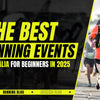First Running Vest? 7 Must-Know Tips Before You Buy
Buying your first running vest can feel like a rite of passage.
You’ve outgrown stuffing gels into pockets and wrestling with backpacks that bounce like kangaroos across the track.
A good vest sits snug against your torso, carries everything you need, and barely lets you know it’s there. In this guide, I’ll take you through the key things to consider when picking up your first hydration vest - no jargon here, and no fluff. Just straight-talk from one runner to another, with the sole objective to help you on your journey to purchase your first running vest.
Now, we are a running vest brand. But in this piece I'm going to try and reduce as much bias as possible, to give you the best advice as a runner.
Why a Running Vest?
You might be wondering: should I just wear a belt? Or perhaps, maybe I'll just use the aid stations on course for my race.
Let me break this down from experience.
Belts absolutely have a place. We design & sell running belts. They're perfect for short runs when you don't require hydration. If you just need to carry your phone and a key, I'd probably recommend you give a belt a go first.
If you're looking to buy a vest for a particular race (assuming it's not mandatory), and you're weighing up whether to rely on aid stations, let me provide some friendly advice.
Aid stations at the best of times are slow, and you're reliant on what they provide.
In races and events where there's a lot of people running, aid stations can be well, a nightmare. It ends up being a large huddle of people vying for a cup of tap water. If you're lucky, maybe you'll snag an electrolyte that you've never tried before.
Worst case scenario; said electrolyte doesn't sit well with you and you're dealing with stomach cramps for the rest of the run.
A proper running vest strikes a balance. It hugs your body, putting weight close to your centre of gravity, so there’s minimal bounce, even when you’re charging uphill or into a headwind. Plus, most vests come with front-pocket hydration, which means you don’t have to twist around for a drink.
Secondly, you decide what you bring, drink & use. You're not reliant on aid stations and you don't even need to stop for a drink (if you don't want to). You use what you've already tested and trained with. Trust me, the last thing you want on race day is a nasty surprise.
Getting the Right Fit
Fit is really important when it comes to your gear. The last thing you want is for a vest that is too big and you spend your long runs thinking about how everything is bouncing.
Look for a vest with adjustable straps - ideally a few, these let you dial in the perfect tension.
If you’re shopping online, pay close attention to torso length measurements and shop with brands that offer a generous return/exchange policy. A vest that’s too long can rub on your lower back; too short and it’ll bob up your spine on every stride.
Now, let me make an important point about bounce.
For half a decade I've researched, observed, designed and analysed running vests. When you're carrying (sometimes) 1-3kg of extra weight through water & other stuff, it's going to move a fraction when you stride. If it doesn't move at all, it's probably too tight and your movements are going to be restricted.
You want to find the right balance, it should be firm with a little bit of give to allow you to run free and unencumbered.
Hydration Options: Flasks vs Bladders
One of the biggest decisions is how you want to carry your fluids. Soft flasks, usually 350 to 500 ml each, tuck neatly into front pockets. They’re quick to grab, refill at aid stations, and they collapse as you drink, so there’s less sloshing.
You'll find that modern runners tend to prefer soft bottles (flasks) over bladders, but it's really personal preference. For longer runs you might decide to use both.
For example our R700 Running Vest comes with both a 2L bladder + 2 x soft bottles, so you might decide to use the whole package for maximum hydration.
Bladders, on the other hand, live in a back pocket and can hold between one and two litres, which is a blessing on longer distances. The trade-off is you’ll need both hands to top up, and the tube can get a bit fiddly. For most of us dipping toes into longer runs, a combo of two soft flasks is a sweet spot, enough water to stay comfortable without overloading your pack.
At the end of the day, there is no right or wrong answer to this. It is completely a personal choice.
Stashing Your Essentials
A vest isn’t just about water. You’ll want room for gels, a phone, keys, maybe even a lightweight rain shell if the weather’s dodgy.
Rather than a rigid checklist of pockets, think about how you run. Do you like grabbing nutrition on the fly? Make sure those pockets sit up front within easy reach. Running through bushland where you don’t want your phone rattling out? Look for zip-pered stash points that keep everything locked in. Some brands mix stretchy mesh with secure zips, giving you the best of both worlds: easy access and peace of mind.
I always recommend looking at vests with numerous pockets on the front of the vest - like five, six or even more.
It's extremely practical have specific compartments for your bits and pieces, so they're not piled into one or two deep pockets.
Materials That Breathe
Nothing turns a good run into a swamp faster than a vest that holds onto sweat. Modern vests use lightweight polyester and mesh panels strategically placed where you heat up most—under the arms and across the back.
The lightest options feel nearly weightless, but can sometimes cost more. If your runs stick to smoother trails or roads, a slightly heavier, tougher fabric might be worth the extra durability. It’s all about finding the balance between weight, breathability and your budget.
It's one of the most common questions I receive, do you want full coverage for weather-resistance like on the R700, or do you want exposed mesh for breathability like on the Hybrid Pro?
It's a personal choice. Consider the type of running you do, and how important breathability and weather-resistance is to you.
Handy Extras
Once you’ve nailed fit, hydration and storage, consider the little extras that make life easier. Reflective detailing can save you from cars on pre-dawn runs.
Tube clips on the shoulder straps stop your hydration hose flapping in the breeze. Gear loops or a built-in whistle can come in handy if you stray off-track. These features aren’t deal-breakers, but they can be important considerations.
Price, Warranty and Peace of Mind
A running vest is an investment in your performance, safety and peace of mind. Entry-level options start around $70, mid-range sits between $100 and $160, and premium vests can be $250-500.
Higher prices usually mean lighter materials, more pockets and longer warranties. But let me tell you, it's not always the case.
A lot of brands will put huge markups on their vests because of 'brand', they often use average materials and they don't come with anything like accessories. Consider what kind of value you're getting.
I can only speak for us, but our R700 literally comes with $105 of hydration accessories included.
Some vests will include hydration accessories, but most don't. Check out the fine print to see if your vest comes with any included accessories.
Always check what kind of repairs or replacements the brand offers. A solid warranty and excellent customer service is really important.
Making the Final Call
Based on what we've spoken about here, consider sizing of the vest as a really important factor - it's something you want to get right. Adjustability is key. Look for value, reviews & brand reputation.
In my 100% unbiased opinion, avoid cheap vests from Amazon/eBay etc like the plague. The amount of runners that come to us after buying a really cheap one is staggering. Don't waste your time.
Make sure wherever you buy your vest from has excellent customer service, a fair warranty period and post-purchase support.
FAQs
Do I need a vest for short runs under 10 km?
If all you carry is keys and phone, a small belt might suffice. But if you like a couple of gels or a light jacket, a vest gives you more flexibility without feeling bulky. Don't get caught up on the old-school 'vest police', you can wear a vest for any distance. Run your own race.
Can running vests double as a hiking bag?
Absolutely. Just check the total weight you pack and pick a vest with some load-bearing features if you’re carrying heavier gear.
How do I clean my vest?
Hand-wash it in cool water with a mild detergent, then hang it out to dry. Never tumble-dry - heat can warp the fabrics and straps.
Choosing your first running vest isn’t rocket science, but it pays to think about fit, hydration style and storage. Aim for a vest that feels snug but not suffocating, carries the right amount of water for your runs, and gives you easy access to essentials.
From there, pick fabrics and features that match your budget and terrain. Give it a few test runs to get the straps dialled, and you’ll be off - hydrated, hands-free striding along like a pro.
One final thought, pick a vest that you actually like the look of. One that gets you excited to chuck it on every time.
A lot of what we have spoken about in this article has been from a pragmatic perspective - fit, value, storage, hydration & visibility. Don't forget to look for things that excite you, running is about enjoyment and this next stage of your running journey with a vest is going be to fun.
Run wild,
Robbie.





